Page 248 of 514
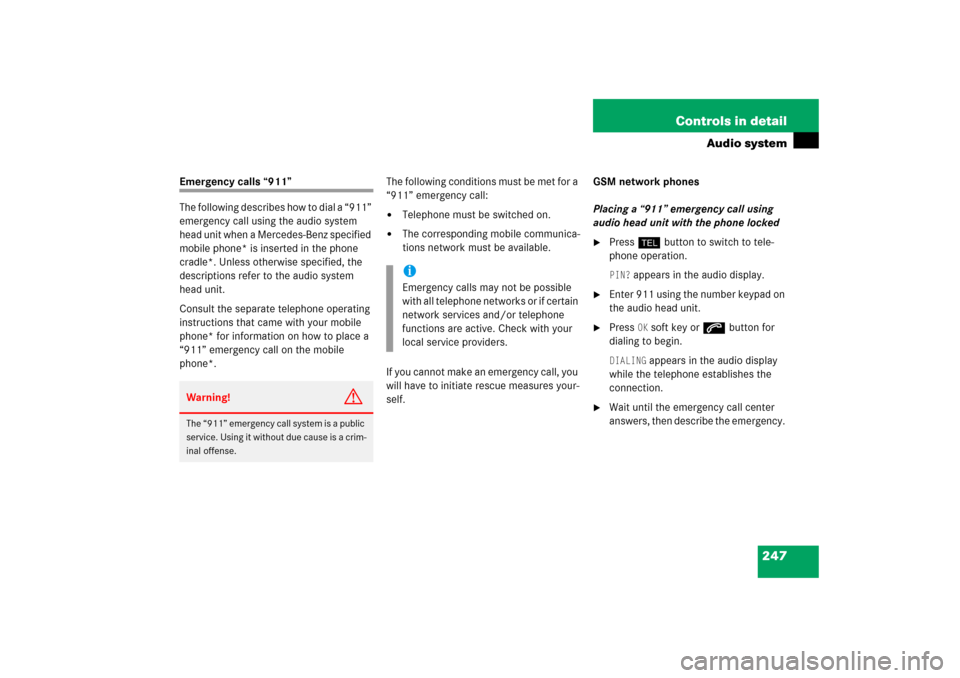
247 Controls in detail
Audio system
Emergency calls “911”
The following describes how to dial a “911”
emergency call using the audio system
head unit when a Mercedes-Benz specified
mobile phone* is inserted in the phone
cradle*. Unless otherwise specified, the
descriptions refer to the audio system
head unit.
Consult the separate telephone operating
instructions that came with your mobile
phone* for information on how to place a
“911” emergency call on the mobile
phone*. The following conditions must be met for a
“911” emergency call:
�
Telephone must be switched on.
�
The corresponding mobile communica-
tions network must be available.
If you cannot make an emergency call, you
will have to initiate rescue measures your-
self. GSM network phones
Placing a “911” emergency call using
audio head unit with the phone locked
�
Press hbutton to switch to tele-
phone operation. PIN?
appears in the audio display.
�
Enter 911 using the number keypad on
the audio head unit.
�
Press
OK soft key or sbutton for
dialing to begin.
DIALING
appears in the audio display
while the telephone establishes the
connection.
�
Wait until the emergency call center
answers, then describe the emergency.
Warning!
G
The “911” emergency call system is a public
service. Using it without due cause is a crim-
inal offense.
iEmergency calls may not be possible
with all telephone networks or if certain
network services and/or telephone
functions are active. Check with your
local service providers.
Page 249 of 514
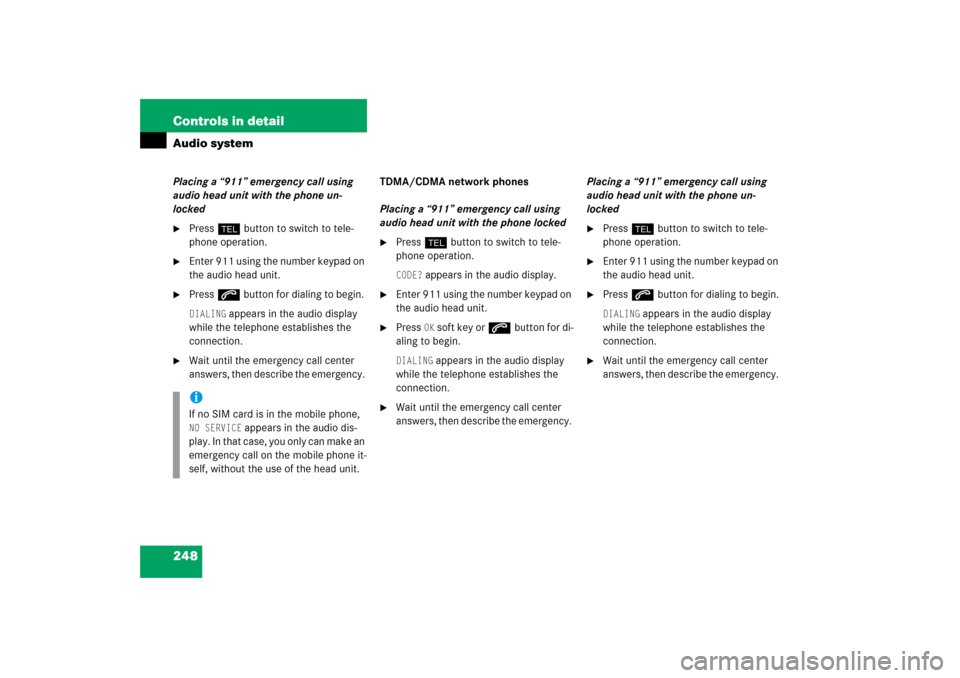
248 Controls in detailAudio systemPlacing a “911” emergency call using
audio head unit with the phone un-
locked�
Press hbutton to switch to tele-
phone operation.
�
Enter 911 using the number keypad on
the audio head unit.
�
Press sbutton for dialing to begin. DIALING
appears in the audio display
while the telephone establishes the
connection.
�
Wait until the emergency call center
answers, then describe the emergency. TDMA/CDMA network phones
Placing a “911” emergency call using
audio head unit with the phone locked
�
Press hbutton to switch to tele-
phone operation. CODE?
appears in the audio display.
�
Enter 911 using the number keypad on
the audio head unit.
�
Press
OK soft key or sbutton for di-
aling to begin.
DIALING
appears in the audio display
while the telephone establishes the
connection.
�
Wait until the emergency call center
answers, then describe the emergency. Placing a “911” emergency call using
audio head unit with the phone un-
locked
�
Press hbutton to switch to tele-
phone operation.
�
Enter 911 using the number keypad on
the audio head unit.
�
Press sbutton for dialing to begin.DIALING
appears in the audio display
while the telephone establishes the
connection.
�
Wait until the emergency call center
answers, then describe the emergency.
iIf no SIM card is in the mobile phone, NO SERVICE
appears in the audio dis-
play. In that case, you only can make an
emergency call on the mobile phone it-
self, without the use of the head unit.
Page 282 of 514
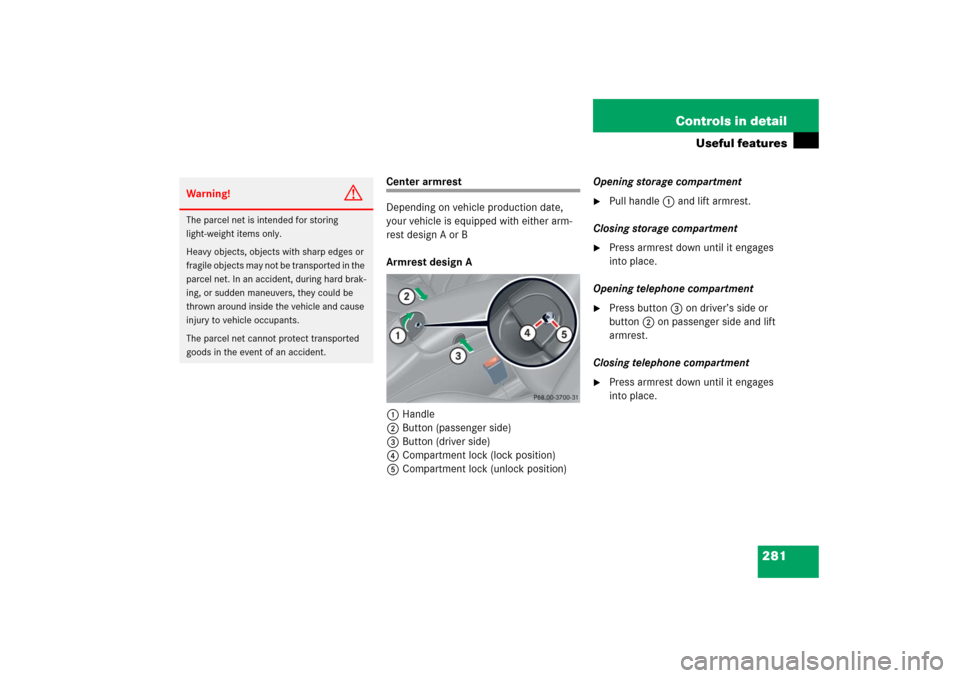
281 Controls in detail
Useful features
Center armrest
Depending on vehicle production date,
your vehicle is equipped with either arm-
rest design A or B
Armrest design A
1Handle
2Button (passenger side)
3Button (driver side)
4Compartment lock (lock position)
5Compartment lock (unlock position)Opening storage compartment
�
Pull handle1 and lift armrest.
Closing storage compartment
�
Press armrest down until it engages
into place.
Opening telephone compartment
�
Press button3 on driver’s side or
button2 on passenger side and lift
armrest.
Closing telephone compartment
�
Press armrest down until it engages
into place.
Warning!
G
The parcel net is intended for storing
light-weight items only.
Heavy objects, objects with sharp edges or
fragile objects may not be transported in the
parcel net. In an accident, during hard brak-
ing, or sudden maneuvers, they could be
thrown around inside the vehicle and cause
injury to vehicle occupants.
The parcel net cannot protect transported
goods in the event of an accident.
Page 283 of 514
282 Controls in detailUseful featuresLocking compartment�
Remove the mechanical key from the
SmartKey (
�page 419).
�
Turn the compartment lock to
position5.
Unlocking compartment
�
Turn the compartment lock to
position4.
�
Insert the mechanical key in the
SmartKey.Armrest design B
The compartment in the center armrest
contains a cup holder and the telephone*
compartment.
1Cover
2Telephone* compartment
3Cup holderOpening compartment
1Cover
�
Slide cover1 in direction of arrow.
Closing compartment
�
Slide cover1 back.
Page 284 of 514
283 Controls in detail
Useful features
Opening telephone compartment�
Slide cover1 in direction of arrow and
open it fully.
Closing telephone compartment
�
Slide cover1 back.Armrest in the rear passenger
compartment�
Pull the top of the armrest out and fold
it down.
Cup holdersWarning!
G
In order to help prevent spilling liquids on
vehicle occupants and/or vehicle equip-
ment, only use containers that fit into the
cup holder. Use lids on open containers and
do not fill containers to a height where the
contents, especially hot liquids, could spill
during braking, vehicle maneuvers, or in an
accident. Liquids spilled on vehicle occu-
pants may cause serious personal injury.
Liquids spilled on vehicle equipment may
cause damage not covered by the
Mercedes-Benz Limited Warranty
When not in use, keep the cup holder
closed. An open cup holder may cause injury
to you and others when contacted during
braking, vehicle maneuvers, or in an
accident.
��
Page 289 of 514
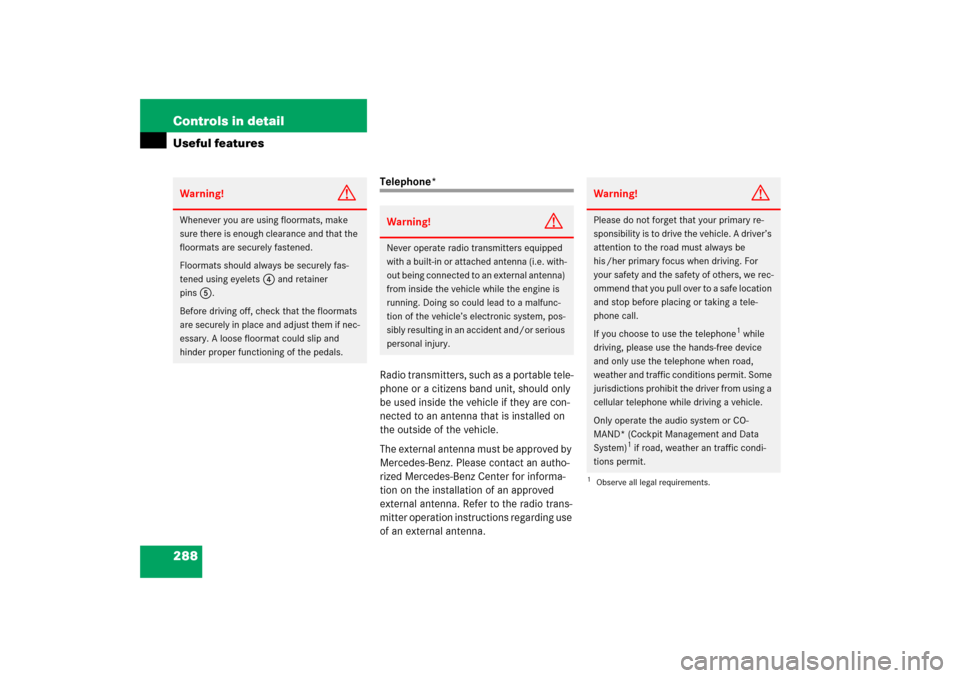
288 Controls in detailUseful features
Telephone*
Radio transmitters, such as a portable tele-
phone or a citizens band unit, should only
be used inside the vehicle if they are con-
nected to an antenna that is installed on
the outside of the vehicle.
The external antenna must be approved by
Mercedes-Benz. Please contact an autho-
rized Mercedes-Benz Center for informa-
tion on the installation of an approved
external antenna. Refer to the radio trans-
mitter operation instructions regarding use
of an external antenna.
Warning!
G
Whenever you are using floormats, make
sure there is enough clearance and that the
floormats are securely fastened.
Floormats should always be securely fas-
tened using eyelets
4
and retainer
pins
5
.
Before driving off, check that the floormats
are securely in place and adjust them if nec-
essary. A loose floormat could slip and
hinder proper functioning of the pedals.
Warning!
G
Never operate radio transmitters equipped
with a built-in or attached antenna (i.e. with-
out being connected to an external antenna)
from inside the vehicle while the engine is
running. Doing so could lead to a malfunc-
tion of the vehicle’s electronic system, pos-
sibly resulting in an accident and/or serious
personal injury.
Warning!
G
Please do not forget that your primary re-
sponsibility is to drive the vehicle. A driver’s
attention to the road must always be
his /her primary focus when driving. For
your safety and the safety of others, we rec-
ommend that you pull over to a safe location
and stop before placing or taking a tele-
phone call.
If you choose to use the telephone
1 while
driving, please use the hands-free device
and only use the telephone when road,
weather and traffic conditions permit. Some
jurisdictions prohibit the driver from using a
cellular telephone while driving a vehicle.
Only operate the audio system or CO-
MAND* (Cockpit Management and Data
System)
1 if road, weather an traffic condi-
tions permit.
1Observe all legal requirements.
Page 290 of 514

289 Controls in detail
Useful features
You can take and place telephone calls
using thes andt buttons on the
steering wheel. To carry out other tele-
phone functions, use the control system
(�page 163).
See separate operating manual for instruc-
tions on how to use the telephone.
Tele Aid
The Tele Aid system
(Tele
matic A
larm I
dentification on
D
emand)
The Tele Aid system consists of three
types of response:�
automatic and manual emergency
�
roadside assistance and
�
informationThe Tele Aid system is operational provid-
ing that the vehicle’s battery is charged,
properly connected, not damaged and
cellular and GPS coverage is available.
The speaker volume of a Tele Aid call can
be adjusted when using the volume control
on the multifunction steering wheel. To
raise, press buttonæ and to lower,
press buttonç. The volume can also be
adjusted using the volume knob on your
audio system or COMAND* head unit.
�
To activate, press the SOS button, the
Roadside Assistance button• or
the Information button¡, depend-
ing on the type of response required.
Bear in mind that at a speed of just 30 mph
(approximately 50 km/h), your vehicle is
covering a distance of 44 feet
(approximately 14 m) every second.
!The initial activation of the Tele Aid
system may only be performed by
completing the subscriber agreement
and placing an acquaintance call using
the¡ button. Failure to complete
either of these steps will result in a
system that is not activated.
If you have any questions regarding
activation, please call the Response
Center at 1-800-756-9018 (in the USA)
or 1-888-923-8367 (in Canada).
iThe SOS button is located above the
interior rear view mirror.
The Roadside Assistance button•
and the Information button¡ are
located below the center armrest
cover.
Page 292 of 514
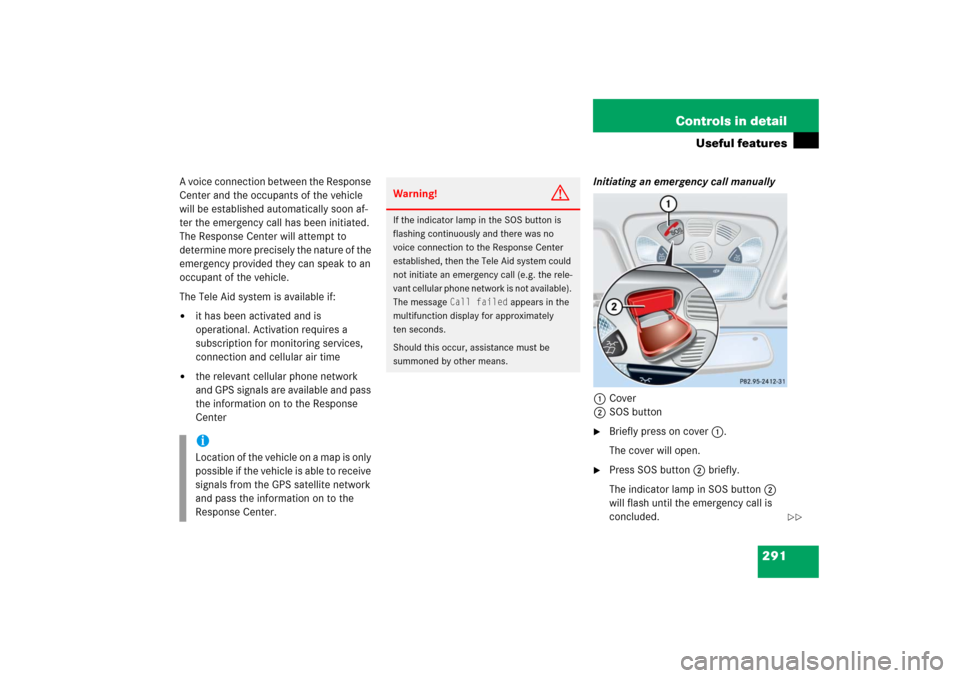
291 Controls in detail
Useful features
A voice connection between the Response
Center and the occupants of the vehicle
will be established automatically soon af-
ter the emergency call has been initiated.
The Response Center will attempt to
determine more precisely the nature of the
emergency provided they can speak to an
occupant of the vehicle.
The Tele Aid system is available if:�
it has been activated and is
operational. Activation requires a
subscription for monitoring services,
connection and cellular air time
�
the relevant cellular phone network
and GPS signals are available and pass
the information on to the Response
CenterInitiating an emergency call manually
1Cover
2SOS button
�
Briefly press on cover1.
The cover will open.
�
Press SOS button2 briefly.
The indicator lamp in SOS button2
will flash until the emergency call is
concluded.
iLocation of the vehicle on a map is only
possible if the vehicle is able to receive
signals from the GPS satellite network
and pass the information on to the
Response Center.
Warning!
G
If the indicator lamp in the SOS button is
flashing continuously and there was no
voice connection to the Response Center
established, then the Tele Aid system could
not initiate an emergency call (e.g. the rele-
vant cellular phone network is not available).
The message
Call failed
appears in the
multifunction display for approximately
ten seconds.
Should this occur, assistance must be
summoned by other means.
��